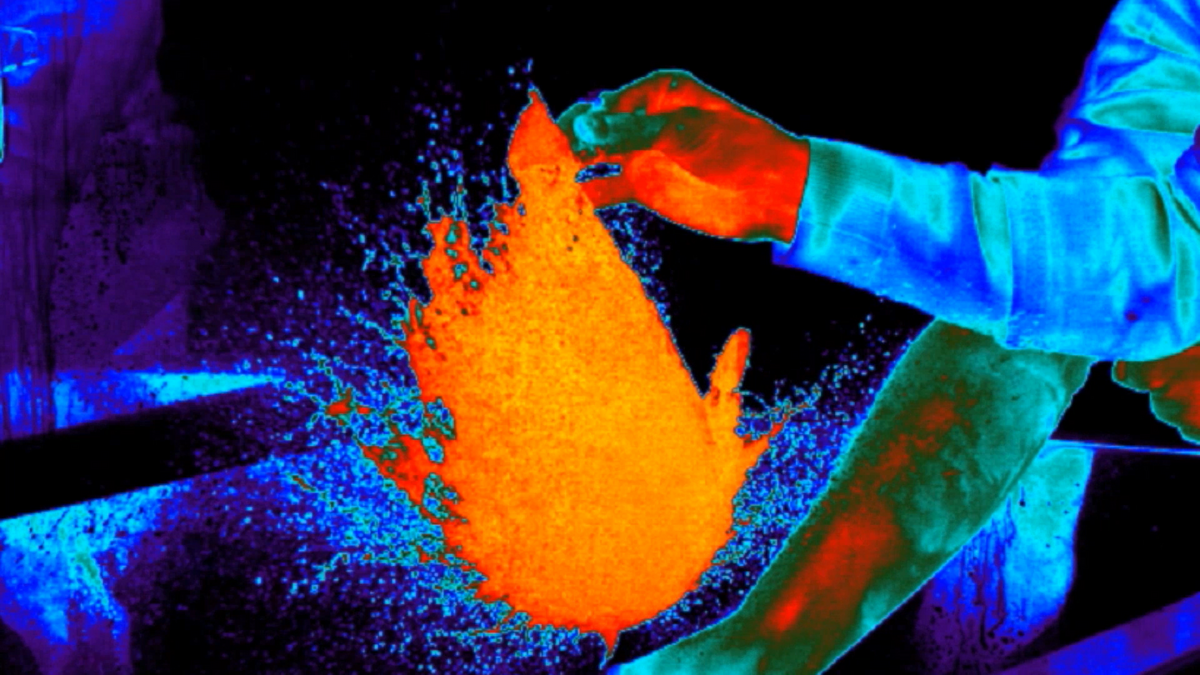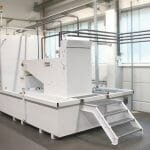Thermal infrared high-speed imaging applications such as airbag deployment testing and ballistics research present quite a challenge for engineers, technicians, and researchers alike. At the heart of that challenge is the choice of the imaging sensor to use for thermal measurement and testing. What’s required is a camera that’s fast enough to stop motion on high-speed targets, yet can still deliver a high level of temperature measurement accuracy.
Without an appropriate tool for adequate thermal measurement and testing, engineers and researchers can lose time and reduce test workflow efficiency. Even more critically, the risk of missing defects that can lead to dangerous products and expensive recalls remains high. With the emergence of next-generation, high-speed infrared cameras, also known as thermal imaging cameras, engineers and researchers now have a viable solution to this dilemma.
While IR cameras are certainly nothing new, the latest high-speed variants bring with them new functionality, a host of benefits, and a few limitations. This Q&A seeks to shed light on some of those functions, benefits, and limitations and, at the same time, address some of the key questions often asked about the technology.
What differentiates this new generation of high-speed IR cameras?
The latest models of high-speed IR cameras improve on the traditional IR camera by incorporating 640 x 512 pixel, high-resolution imaging sensors capable of capturing images at a rate of anywhere from 1,000 frames per second (fps) to above 30,000 fps. Additionally, they employ next-generation readout integrated circuits and the latest detectors, such as those based on strained layer superlattice (SLS) material. SLS-based sensors offer the ability to image objects over a wide temperature range with great image uniformity and quantum efficiency far beyond that of more traditional detectors (e.g., mercury cadmium telluride-based detectors and quantum well infrared photodetectors). These advances enable newer high-speed IR cameras to achieve the short snapshot speeds and high frame rates needed for demanding high-speed thermal applications (Figure 1).
How do high-speed thermal cameras compare to other forms of temperature measurement, such as thermocouples or spot pyrometers?
Thermocouples and spot pyrometers are tools commonly used to measure heat only at a single specific point on an object. These devices are relatively low cost, but they offer an incomplete picture of a target’s thermal properties compared to thermal image data. Additionally, spot pyrometers generally lack the response rates necessary to take accurate readings on fast-moving objects or to thermally characterize high-speed targets. Thermocouples can’t be practically mounted on moving objects to measure heat.
In comparison, infrared cameras offer highly accurate temperature measurement for each pixel in every frame of data. It’s like having hundreds of thousands or even millions of points of non-contact temperature measurement at the push of a button. This allows you to characterize objects that are moving and wouldn’t be practical for mounting a probe. You get a full picture of the thermal gradients on your object, rather than just the few disparate temperature points that spot pyrometers offer.
How do high-speed, cooled IR cameras differ from other infrared cameras on the market today?
There are two broad categories of thermal IR cameras on the market. The first are based on uncooled microbolometer detectors. These cameras are durable, portable, and low in price, but have slow frame rates (around 60 frames per second) and response times (time constants) that make it difficult to produce crisp, stop-motion images of fast-moving objects (Figure 2A). Slow frame rates also prevent these cameras from accurately characterizing objects that heat up or cool down very quickly.
The second type of IR cameras uses cooled quantum detectors, which include indium antimonide [InSb], indium gallium arsenide [InGaAs], and SLS. These cameras can have short integration times and much faster frame rates (Figure 2B). Snapshot speeds and frame rates vary, depending on the camera and its resolution, but high-speed IR cameras with quantum detectors can be fast enough to stop motion on rifle bullets and other hypersonic targets and accurately measure very fast temperature transients. Most of these special cameras have sensors with a minimum of 16 high-speed output channels, and processing speeds (pixel clock rates) of at least 200 MPix/sec, while low-performance cameras have four channels and run at pixel clock rates below 50 MP/sec. Cooled cameras are also highly sensitive and can detect subtle temperature changes, as little as 0.02 degrees Celsius — a 30 percent improvement in sensitivity over uncooled cameras. Moreover, they produce less digital noise and more finely detailed images.
An advantage of next-generation cooled IR cameras over earlier models lies in the Readout Integrated Circuit (ROIC). Older detectors use ROICs that are non-linear at low exposures or well fills, which often leads to poor image quality and questionable temperature measurement accuracy. By comparison, newer high-speed IR cameras use ROICs that are linear all the way to low well fills.
What are the advantages of using a high-speed IR camera?
The key advantage is that they offer the short snapshot speeds and high frame rates needed to visualize and take accurate temperature readings on extremely fast-moving targets. In addition, their high sensitivity and ability to detect subtle temperature changes helps users better detect small hot spots. Linearity at low fill wells means they can accurately measure colder targets at high speeds.
If the camera detector is made from SLS, it gains an added advantage: the ability to detect longwave IR (LWIR) in the 7.5 to 9.5 μm spectral range. SLS detectors can be operated at extremely short integration times – up to 12 times faster than InSb detectors, are more efficient than other quantum detectors, and offer more thermal contrast when imaging cold targets. LWIR SLS detectors also generally have much wider temperature ranges, which is extremely useful if the target in question heats up across a wide range of temperatures.
What applications most benefit from high-speed IR cameras?
Virtually any high-speed or fast motion application could benefit from these cameras. However, some of the key research applications include ballistics, supersonic projectiles, explosives, combustion processes, and lasers. Product research and development on internal combustion engines, brake rotors and tires, and high-speed airbags are other application areas of interest for these cameras. In the automotive arena, for example, high-speed IR cameras can be used to help engineers identify airbag defects, such as micro-cracks in passenger activation systems or defective inflators, which can result in dangerous products and costly car recalls.
How do high-speed infrared cameras compare to high-speed visible cameras?
IR cameras operate in the IR range of the electromagnetic spectrum (700 nm to 1 mm in wavelength), while visible cameras operate in the visible region (400 to 700 nm). The latest high-speed IR camera models utilize a number of technologies first used in high-speed visible cameras. Some of those technologies include on-camera RAM for image storage, removable solid-state drive shuttles, short exposure times, trigger start, and synchronization inputs/outputs.
As an example, consider the visible camera’s synchronization and trigger start. In a high-speed IR camera, the ability to synchronize and trigger to external events, such as a rotating brake disc or the ignition of a combustion engine, is critical for accurate measurement and testing. When a camera system is running on an internal clock, the detector’s integration start point and data output are set by that clock. What that means is that if an event doesn’t correspond exactly with the integration period, part of the event or even the entire event could be missed. This is where the triggering system comes in. It bypasses the problem by better synchronizing recordings, which is done by strictly controlling the integration start time and the frame rate from external signals generated by the event being studied. A rifle bullet can be imaged by triggering the acquisition of a frame of image data based on a microphone picking up the sound of the rifle firing.
Are there any limitations or tradeoffs associated with next-generation high-speed IR cameras?
Yes. One limitation is that if the target is not hot enough, there may not be enough energy to get a sufficiently high signal-to-noise ratio. And, while next-generation high-speed thermal cameras allow users to tackle difficult high-speed thermal applications for the first time, there is a limit to how fast they can go.
How fast is too fast for a high-speed IR camera?
The issue with ultra-fast frame rates is the tradeoff that occurs between that speed and the camera’s measurement accuracy. Consider that one of the fastest thermal detectors used in ultra-high-speed thermal cameras today was designed to operate with a 12.8 Mpix/sec clock rate for all 16 channels of the readout. It uses a special zero-dead-time mode that allows it to achieve faster-than-typical frame rates when compared with other detectors designed around the same time. In this mode and at a minimum window size of 64 x 2, the detector yields a maximum frame rate of just over 39,000 fps. The persistence is less than 1 percent from the previous frame at 90 percent full-well.
What happens when camera manufacturers overclock the readout to achieve faster frame rates, say upwards of 90,000 fps? Running the camera at frame rates outside the readout design boundaries creates multiple potential issues, most notably, the issue of persistence between frames. Overclocking doesn’t allow for the integration capacitors to be fully cleared of photocurrent charge from the previous frame. This results in some residual charge when collecting the next frame. That residual charge compounds in subsequent frames, causing readings with mixed data and leaving the user to wonder what charge was from the new frame and what was left over from previous frames.
What impact does this have on your measurements?
Ultimately, the accuracy of any measurements calculated from the mixed data becomes questionable. Accuracy further deteriorates when using data containing an unknown amount of persistence charge from previous frames and new data collected. So, while the 90,000 fps may sound exciting on the surface, the methods used to achieve such rates can cause troubling results that make any measurements inaccurate and arguably unusable.
What happens when you overclock the readout to achieve faster frame rates?
Overdriving the ROIC past its design limits has several negative effects. It leads to inaccuracies in radiance and temperature measurements, as well as imaging artifacts and degradation stemming from non-linearity at low well fill (Figure 3). Take the previous frame rate of 90,000 fps as an example. The resultant integration time needed to achieve this is 11.1 µs. With such a short snapshot speed, the target needs to be sufficiently hot to emit enough photons in the infrared band to get a good image. Oftentimes, the high-speed event is simply not hot enough to fill the integration capacitor with enough charge to get quality imagery. At best, one would be operating at the low end of the well fill, where older ROICs have a roll off at the low end of the dynamic range. The response would look like an “S” curve instead of a straight line. Because older-generation ROICs are non-linear at low well fill, the non-uniformity and calibrations wouldn’t calculate correctly and measurements on that data would be, for the most part, rendered useless.
If imaging artifacts and degradation do occur, what might the user see?
When imaging artifacts occur, the user sees degraded imagery. Often, it shows up as vertical striations in the thermal image (Figure 4).
What does the future hold for high-speed IR cameras?
The sensitivity, speed, and accuracy of next-generation, high-speed IR cameras make them a compelling option for a range of applications, today and in the future. They promise to empower engineers and scientists to obtain thermal data on applications that simply weren’t possible before now, and to help them expand their testing capabilities in areas such as ballistics, munitions testing, and high-speed target tracking. Moving forward, when engineers and scientists want to improve their designs and overall performance of those designs, the data integrity that comes from using the latest, high-accuracy, high-speed IR camera will be essential.
For more information on high-speed IR cameras, go to www.FLIR.com.





